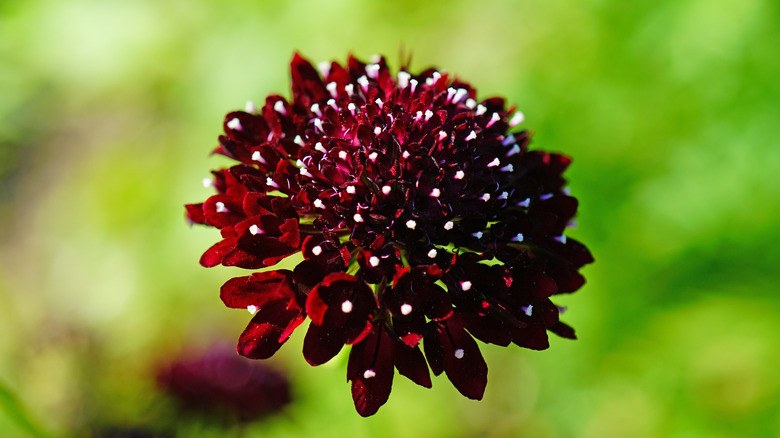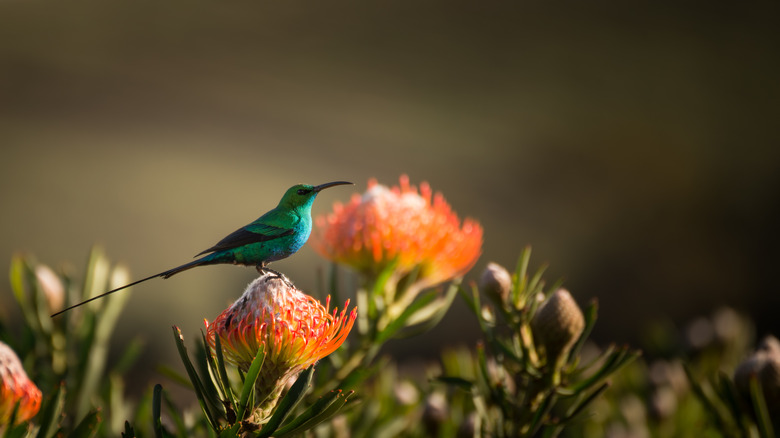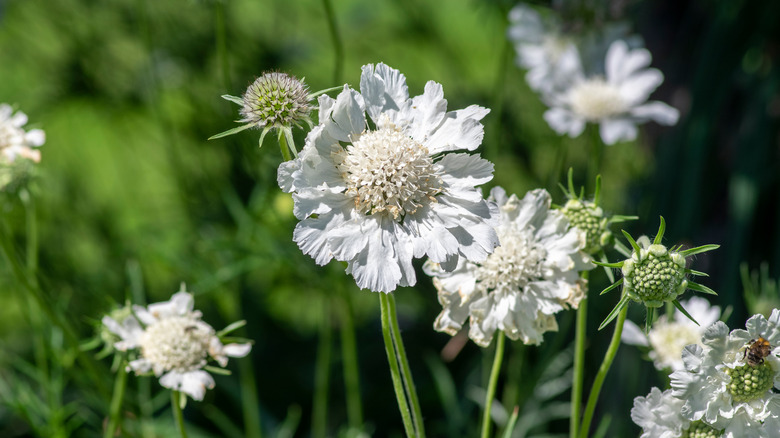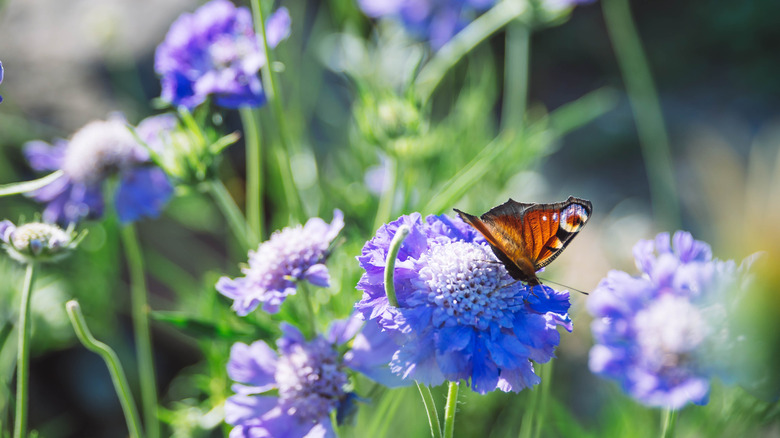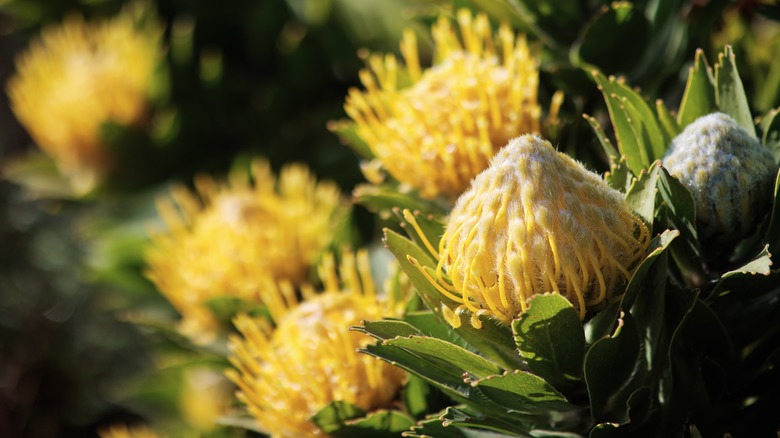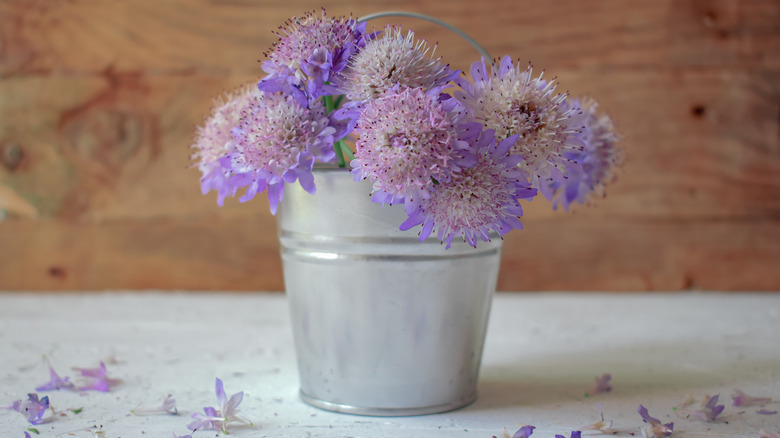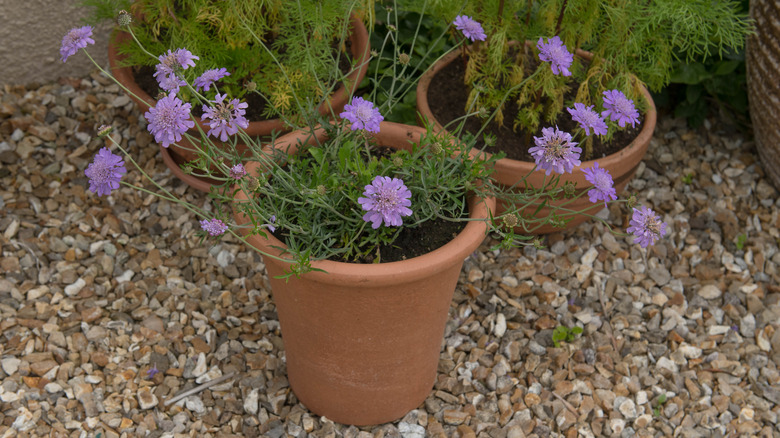How To Care For A Pincushion Flower
Pincushion flowers (scabiosa atropurpurea and scabiosa caucasica) add a burst of color with minimal manpower. These European natives from the honeysuckle family remarkably versatile and have become a popular way to lend color to a garden because they thrive in a number of climates.
As a member of the scabiosa genus, pincushions are known for their basal leaves (lance-shaped) and stem leaves that are clearly dissected. They get their household name from the flower's puffy center and stamens resembling a tailor's pincushion. The plant blooms in summer, and the experts at Gardening Know How are quick to mention that some reach more than a foot or two above their foliage, which appears either blue-green or a deep gray. Blooms present in an assortment of colors, from cream, lavender, and blue to red and purple.
There are two varieties to keep in mind: One, the annual pincushion (scabiosa atropurpurea) requires replanting every year, although, in some areas, they could reseed. Most often, annual pincushion flowers are smaller than their perennial relatives, and they offer a wider assortment of colors, often appearing in shades of lavender-blue, rose, deep maroon, pink, and white.
Perennial pincushion flowers (scabiosa caucasica) plants generally present in shades of white or blue, although it's not unusual to find pink, too. In bloom, the flowers are also larger at approximately 2 ½ to 3 inches and will often bloom from late spring/early summer or until the first frost. Unlike their annual counterparts, their foliage remains green year-round.
How to use pincushion flowers in the garden
Principally, pincushion flowers are used in gardens because they provide an accent of color, and because they also attract pollinators like bees and butterflies. Pincushion flowers are adaptable, too — which means you can plant them in a flower bed or potted in containers. Their flowering season (from summer to early fall) and elongated stems make them a great option for use in cutting gardens.
But the real not-so-hidden advantage to growing them is that these herbaceous perennials are anything but work-intensive. It's best to put them in the soil in early spring (cooler climates require them being started indoors), and, from there, most will grow steadily until they reach maturity in about three months' time.
While they are considered hearty, there are certainly less-than-optimal environments for them. They do not enjoy the cold, soggy weather or excessively hot and humid climates. And since variations in weather may cause them to flop, consider planting them by other flower that are sturdier and can help hold them up.
How to grow pincushion flowers
Horticulturists at The Garden Helper suggest planting pincushions from 12 to 15 inches apart in a spot where they'll get the benefit of full sun exposure during the day, although they've done well in places where they've gotten only partial sun or shade. Since that's far from optimal, you can also expect that to affect the resulting plant and blooms: they'll generally be weaker and shorter.
If you live in an environment where the afternoons are hot, you'll want to make sure you've got some shade to offer them refuge. They're especially unhappy with soggy wintery soil, so it's important that you're providing the necessary drainage to keep them from getting waterlogged. Through regular watering during the first season, you can promote the development of a healthy root system that will serve the plant as long as you wish to keep it. This will also help them navigate mild droughts.
How to care for pincushion flowers
Pincushion flowers prefer lots of sun and a well-drained but moist soil that's somewhere between neutral and slightly alkaline. According to the florists at Gardening Channel, you should be in the ground ahead of your plant, treating the soil with compost, manure, or moss. You'll get a better result in the second year after they're outside if you treat them with a granular fertilizer that time-releases its nutrients. For the best results, you'll want to spend a few moments to work the fertilizer thoroughly into the surrounding soil.
When necessary, the stems can be cut all the way back to the bottom leaves to improve the appearance of the plant. Cut the foliage back to the ground after the first frost. Take precautions to protect your pincushion flowers from slugs and snails, as well. Both of these garden pests can harm your plants, but there are ways to keep them away.
Varieties of pincushion flower
Researchers at Brittanica say that the major species of the flower (also known as mourning bride, garden scabious, or sweet scabious (scabiosa atropurpurea) includes a "dwarf pincushion flower" (S. columbaria), found mostly in Africa, which will only grow to 24 inches. It, too, is a perennial and identified by its oval basal leaves and cut stem leaves. The light blue flowers are about 1 1/2 inches across. As a distant relative, devil's bit is also mentioned since it too is in the scabious family and belongs to the nearby genus succisa.
While the pincushion flower is most often divided into annual and perennial varieties, both provide a staggering array of possible colors. In fact, they vary so widely in color that without any additional flowers at all, an assortment of pincushions can make for a spectacular bouquet. At Johnny's Selected Seeds, the choices will include such stunners as fire king, fama deep blue, merlot red, and snow maiden, just to name a few.
None of these is known to be toxic. And while they are deer resistant, cats and dogs who find them edible do so without danger, although it's said that if an animal finds them appetizing enough, stomach issues could result.
How to repot pincushion flowers
Balcony Garden Web points out that you can grow pincushion plants in nearly every climate, these plants also take to being cultivated in containers. While their long flowering season and ease of care make them as much a pleasure indoors as outside, you will want them to receive only partial sun if you live in the hotter parts of the country.
In addition, The Gardening Channel attests that the only thing the pincushion flower plant doesn't like is extremes. That means an environment that's extremely hot or cold, or too often humid or wet. They respond robustly to organic-rich potting materials, so you should prepare a new home for your plant by treating your soil with compost, manure or moss.
A little fertilizer, particularly one that's granular and time-release, is also recommended once a year early in the springtime. It's also important to not just sprinkle the fertilizer around your plant; you want to get in there with gloves and gently work it through the soil mixture for maximum effect.
What you need to know about pincushion flowers
From time to time, spider mites, whiteflies, and aphids have all infested pincushions. A small infestation can be removed with a garden hose, but if the parasites have a more firm grip, an application of insecticide might be needed to remove them permanently. (Your local plant retailer will have suggestions.) Pincushion flowers are also considered invasive, meaning they can grow quickly and take up space you might want used otherwise.
The real key to getting the most out of the plant, according to Gardener's HQ, is to "deadhead," or remove the flowers as they finish blooming, which nudges the plant to refocus on its next generation of growth. And lastly, don't forget to prune your plants back as fall arrives, and remember that these plants will also need to be staked in many areas because their stems are fragile and can snap without much provocation.
